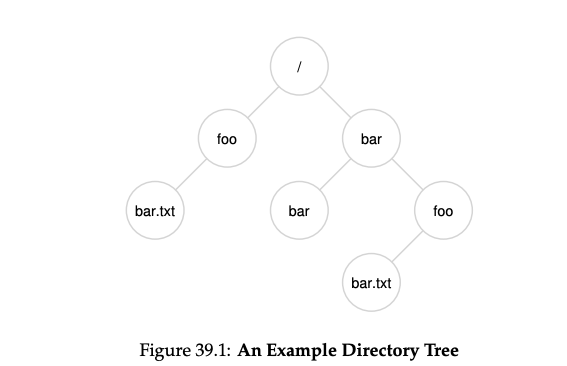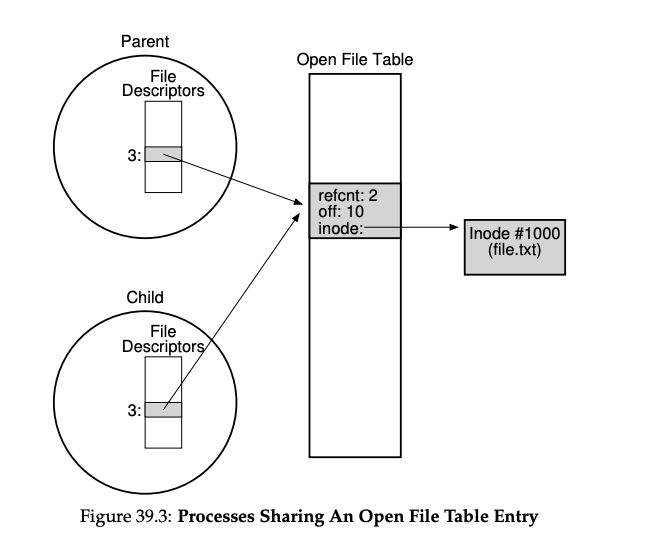Files And Directories
- File - A file is simply a linear array of bytes, each of which you can read or write
- Directory - A directory, like a file, also has a low-level name (i.e., an inode number), but its contents are quite specific: it contains a list of (user-readable name, low-level name) pairs
Example

Interface
Let’s now discuss the file system interface in more detail. We’ll start with the basics of creating, accessing, and deleting files
Creating Files
int fd = open("foo", O_CREAT|O_WRONLY|O_TRUNC,
S_IRUSR|S_IWUSR);
One important aspect of open() is what it returns: a file descriptor. A file descriptor is just an integer, private per process, and is used in UNIX systems to access files; thus, once a file is opened, you use the file descriptor to read or write the file, assuming you have permission to do so.
Reading And Writing Files
$ strace cat foo
...
open("foo", O_RDONLY|O_LARGEFILE) = 3
read(3, "hello\n", 4096) = 6
write(1, "hello\n", 6) = 6
hello
read(3, "", 4096) = 0
close(3) = 0
Process Sharing

Buffering
Most times when a program calls write(), it is just telling the file system: please write this data to persistent storage, at some point in the future.
When a process calls fsync() for a particular file descriptor, the file system responds by forcing all dirty (i.e., not yet written) data to disk, for the file referred to by the specified file descriptor.
Getting Information About Files
Beyond file access, we expect the file system to keep a fair amount of information about each file it is storing. We generally call such data about files metadata. To see the metadata for a certain file, we can use the stat() or fstat() system calls.
struct stat {
dev_t st_dev; // ID of device containing file
ino_t st_ino; // inode number
mode_t st_mode; // protection
nlink_t st_nlink; // number of hard links
uid_t st_uid; // user ID of owner
gid_t st_gid; // group ID of owner
dev_t st_rdev; // device ID (if special file)
off_t st_size; // total size, in bytes
blksize_t st_blksize; // blocksize for filesystem I/O
blkcnt_t st_blocks; // number of blocks allocated
time_t st_atime; // time of last access
time_t st_mtime; // time of last modification
time_t st_ctime; // time of last status change
};
Removing Files
$ strace rm foo
...
unlink("foo") = 0
...
Removing a file doesn’t wipe it from the disk! The file is still there just not directly accessible! Deleted files can still be recovered (for a while).
Symbolic Links
- There is one other type of link that is really useful, and it is called a symbolic link or sometimes a soft link.
- This allows you to create a link or pointer to a file
Permission Bits
$ ls -l foo.txt
-rw-r--r-- 1 remzi wheel 0 Aug 24 16:29 foo.txt
- The first character here just shows the type of the file: - for a regular file
- The permissions consist of three groupings: what the owner of the file can do to it, what someone in a group can do to the file, and finally, what anyone (sometimes referred to as other) can do.
Mounting file systems
Linux has a single root for its directory while windows has a multi-root approach.
mount -t ext3 /dev/sda1 /home/users